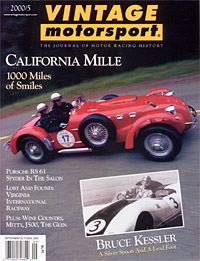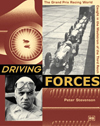|
Driving Forces
Price: $19.95
|

Vintage Motorsport September/October 2000
Vintage Picks by David Woodhouse
The prewar German Grand Prix cars remain among the most fascinating of machines for Vintage Motorsport readers. The Auto Union display at Montery last year drew a huge crowd, and Mercedes-Benz has been generous in sending its museum pieces to vintage events around the world. There is a shelf full of books on grand prix racing in the 1934-1939 period, but such was the horror of the World War immediately following, that most authors have chosen to concentrate on the machines and race results, treading very lightly on political events.
Peter Stevenson takes a different tack and Driving Forces reads like a novel, thrilling the reader with the personal struggles of two principles, Rudi Caracciola and Bernd Rosemeyer, as they and the rest of the racing world were swept along by events that brought fame and fortune, but extracted a terrible price in the end. The stage sponsored racing effort at first worked to the racers’ advantage, with quantum leaps in technology that made the French and Italian competition obsolete almost overnight and turned Rudi and Bernd, along with their teammates, into national heros.
While pleased with the prestige earned by the racing successes, Hitler’s goal of working class Germans happily zipping across the the country’s network of autobahns in their Volkswagens was running behind and political screws began to tighten on the motor industry and the racing efforts. Gradually the pressure increased and political expediency began to dictate who should win a particular Grand Prix. This intolerable situation reached a breaking point as the Nazis demanded new speed record attempts during January of 1938. In a particularly vivid description of the autobahn runs that resulted in Rosemeyer’s death, the racing community comes to realize the pact they have made with the devil.
Driving Forces will not replace Chris Nixon’s Racing the Silver Arrow as the definitive volume on the subject, but it is exciting reading and does offer a less sterile perspective. I enjoyed it thoroughly. Stevenson has included and appendix of resource material for each chapter that will help those wishing for more information, and an epilogue telling how he first discovered those fantastic machines through the early postwar Floyd Clymer publications-an experience shared by many of us.

![[B] Bentley Publishers](http://assets1.bentleypublishers.com/images/bentley-logos/bp-banner-234x60-bookblue.jpg)
